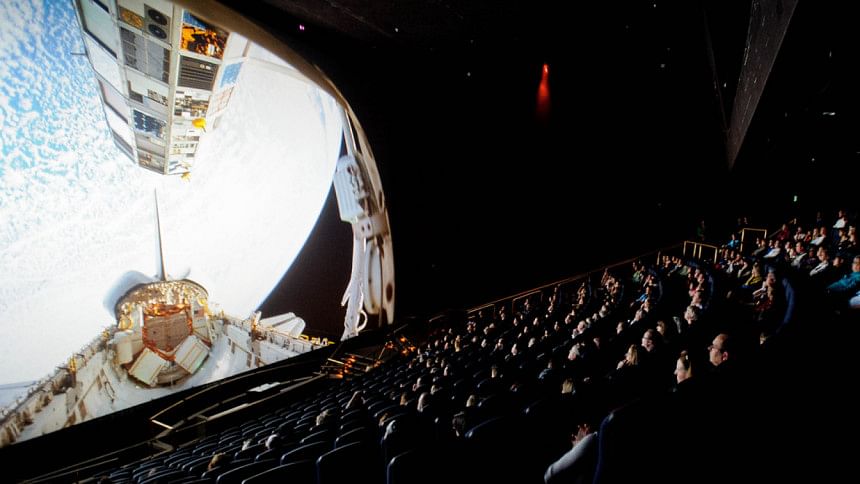The IMAX experience: What Bangladeshis are missing out on

Every few years, the release of certain films reignites the buzz surrounding IMAX. During these movie seasons, it becomes the focal point of discussion among film enthusiasts. But what exactly is IMAX, and why should it matter to the average cinema-goer?
IMAX, an acronym for 'Maximum Image', encompasses a unique ecosystem of specialised cameras, film rolls, theatres, and projectors. Together, they aim to offer an almost 'out-of-body' immersion in film viewing, if fan testimonials are to be believed. In comparison to the standard film screens in Cineplex theatres across Bangladesh, IMAX screens provide 26% more viewing space due to their taller dimensions. Furthermore, IMAX theatres utilise dual projectors to enhance luminance, allowing, as director Christopher Nolan puts it, the screen to "disappear".
The IMAX film roll comes in two formats: 35mm and 70mm. Without diving deep into technicalities, the 70mm version is widely recognised as the pinnacle of imaging formats, surpassing current digital imaging capabilities. It boasts a 1.43:1 aspect ratio and a rich colour palette. However, the ultimate viewing experience hinges on whether the film was shot using the powerful, albeit noisy, IMAX film camera. Its motorised components, pushing 15 frames per second, make it so loud that directors often avoid recording dialogues with it.
Christopher Nolan's 'Oppenheimer' recently reignited interest in IMAX cinematography. Although IMAX cameras have been around since the early 70s, it was Nolan who truly championed the technology. He has consistently favoured analogue filmmaking, evident in hits like 'The Dark Knight', 'Inception', and 'Interstellar'. However, Nolan isn't the sole advocate; films ranging from Tom Cruise's 'Mission Impossible: Ghost Protocol' to Jordan Peele's 'Nope' have utilised IMAX. As its popularity grows, more filmmakers are keen to embrace the challenges of shooting with IMAX. Yet, what's the benefit if the enhanced visuals and sound are lost in Bangladesh's standard cinema halls?
Despite its global acclaim, IMAX remains absent from Bangladesh. Regardless of a director's efforts to craft the perfect viewing experience, Bangladeshi fans must make do with standard Dolby Cinema theatres, missing out on the mesmerising quality of IMAX cinema. But is there a genuine demand for IMAX, or is it merely a niche preference?
Opinions among cinema-goers are divided. Salehin, a theatre regular, remarked, "I watched 'Interstellar' in IMAX in India, and it was unparalleled. But watching 'Blade Runner' in Bangladesh just didn't compare." On whether IMAX caters to a niche audience, he believes it's more about raising awareness of IMAX's superior quality. "If introduced here, with effective marketing, many would opt for this 'premium' experience."
However, Mushfiq, another film enthusiast, feels differently: "The Bangladeshi audience hasn't shown significant interest in IMAX. And with a limited IMAX movie catalogue, fans have to settle for what's available. Most viewers remain indifferent."
When we approached officials from Star Cineplex's parent company, Show Motion Ltd, they remained reticent, suggesting it wasn't the right time to introduce the technology in Bangladesh, without elaborating further. This raises the question: if not now, when? Especially when there's a surge in audiences for original films unrelated to major franchises.
Bangladesh seems to be overlooking a golden opportunity presented by this global cinematic trend. For now, fans can only wait in anticipation.

 For all latest news, follow The Daily Star's Google News channel.
For all latest news, follow The Daily Star's Google News channel. 




Comments